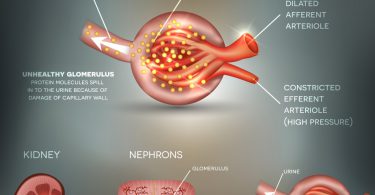ABSTRACT-
Hyperlipidaemia refers to the elevated levels of fats that are lipids, cholesterol, triglycerides (TGs) or all in our body. Elevated levels of blood lipids levels are well documented risk factors for cardiovascular diseases and it increases the risk for stroke and death. Diagnosis and management of hyperlipidaemia as a way to prevent Cardiovascular diseases (CVC) is a common activity for primary care physicians. Physicians need to have a detailed knowledge about hyperlipidaemia and a well-reasoned action plan for its management. In this article we will discuss hyperlipidaemia in detail and will explore that how Homoeopathy can act wonderfully in its management.
KEYWORDS- Hyperlipidaemia, Cholesterol, Cardiovascular diseases, Arteriosclerosis, Homoeopathy, Lipids
INTRODUCTION-
Hyperlipidaemia, means that high levels of fats (or lipids) are in the blood. These fats include cholesterol and triglycerides. They are important for our bodies to function but when they are too high, they can put people at risk for heart disease and stroke.1 The global increase in the prevalence of hyperlipidaemia is due to unhealthy eating habits, obesity and physical inactivity.2 The problem can be due solely to hereditary factors, but more commonly it is an acquired condition.3
Modern primary care practitioners spend considerable time and effort on preventative medicine. Diagnosing and managing hyperlipidaemia as a way to prevent cardiovascular disease (CVD) is a common activity for primary care physicians. Physicians need to know the major categories of hyperlipidaemia and to have a well-reasoned action plan for dealing with each one, including knowing when to refer a case to a lipidology specialist.3
WHAT IS HYPERLIPDAEMIA?
Hyperlipidaemia is an increase in one or more of the plasma lipids, including triglycerides, cholesterol, cholesterol esters and phospholipids and or plasma lipoproteins including very low-density lipoprotein and low-density lipoprotein, and reduced high-density lipoprotein levels. Hypercholesterolemia and hypertriglyceridemia are the main cause of atherosclerosis which is strongly related to ischemic heart disease (IHD). There is a strong relation between IHD and the high mortality rate. Furthermore, elevated plasma cholesterol levels cause more than four million deaths in a year.4
FATS IN OUR BODY-
Lipoproteins: These are large globular particles that contain an oily core of nonpolar lipid (cholesteryl esters of triglycerides) surrounded by a polar coat of phospholipids free (i.e. unesterified) cholesterol and apoproteins. There are six classes of lipoproteins (Chylomicrons, VLDL, IDL, HDL, LDL, Lp(a)) that differ from one another in size, density and properties of triglycerides and cholesterol.2
Cholesterol
It is a vital component of the mammalian cell membrane of all tissues and is a precursor of steroid hormones and bile acids. It occurs, either free or as many fatty esters in all animal cells, but is absent in plant fats.2
Triglycerides
These are the most abundant of all lipids. It is found abundantly in adipocytes. These are major components of storage fats in plant and animal cells. Excess calories, alcohol and sugar in the body get converted into triglycerides and stored in fat cells throughout the body.2
Too much LDL, or “bad” cholesterol, can build up in the arteries (the blood vessels that carry blood throughout the body) and, over time, cause heart disease or stroke. On the other hand, having too much HDL, or “good” cholesterol, protects the heart by helping to remove the building up of LDL from the arteries. Low levels of HDL and high triglycerides can also increase fat build up in the arteries and cause heart disease, especially in people who are obese or have diabetes.1
Pathogenesis of hyperlipidaemia
Cholesterol, triglycerides, and phospholipids are transported in the bloodstream as complexes of lipid and proteins known as lipoproteins. Elevated total and low-density lipoprotein (LDL) cholesterol and reduced high-density lipoprotein (HDL) cholesterol are associated with the development of coronary heart disease (CHD).
During the early stages of the hyperlipidaemia, blood monocytes and platelets attach to a vessel wall at the sites of endothelial damage. The release of the mediators such as platelet derived growth factors leads to a proliferation of smooth cells in the intimal and medial lining of the vessel, collagen synthesis, cholesterol uptake and the beginning of the hyperlipidaemic plaque results. Plaque ruptures are resulting in the acute syndromes of unstable angina, myocardial infarction and sudden cardiac death.2
Hyperlipidaemia classification
Hyperlipidaemia in general can be classified to:
Familial (Primary) hyperlipidaemia it is also called familial due to a genetic defect; it may be monogenic: a single gene defect or polygenic: multiple gene defects. Primary hyperlipidaemia can usually be resolved into one of the abnormal lipoprotein patterns.4
According to Fredrickson familial hyperlipidaemia is classified into five types on the basis of electrophoresis or ultracentrifugation pattern of lipoproteins.
• Type I–Raised cholesterol with high triglyceride levels.
• Type II–High cholesterol with normal triglyceride levels.
• Type III–Raised cholesterol and triglycerides.
• Type IV–Raised triglycerides, atheroma and uric acid.
• Type V–Raised triglycerides.
This classification was later adopted by WHO.2
Acquired (Secondary) hyperlipidaemia it is acquired because it is caused by another disorder like diabetes, nephrotic syndrome, chronic alcoholism, hypothyroidism and with use of drugs like corticosteroids, beta blockers and oral contraceptives. Secondary hyperlipidaemia together with significant hypertriglyceridemia can cause pancreatitis.4
Most common causes of acquired hyperlipidaemia are2
• Diabetes Mellitus
• Use of drugs such as diuretics, β-blockers and oestrogens.
• Alcohol consumption.
• Some rare endocrine disorders and metabolic disorders.
• Hypothyroidism
• Renal failure
• Nephrotic syndrome
CAUSATING FACTORS AND RISK FACTORS OF HYPERLIPIDAEMIA
Causes of hyperlipidaemia
A diet rich in saturated fat and cholesterol increases blood cholesterol and triglyceride levels, Other disorders as obesity, diabetes mellitus and hypothyroidism increase the risk of hyperlipidaemia, Smoking and not exercising may lead to hyperlipidaemia, Excessive use of alcohol also increases the risk of hyperlipidaemia, Certain drugs as steroids and β–blockers may cause hyperlipidaemia, Hereditary factor is also one of the common causes for hyperlipidaemia, In some cases, hyperlipidaemia occurs during pregnancy, Lipoprotein lipase mutations.2 These are the major causing factors of Hyperlipidaemia.
Risk factors of hyperlipidaemia
Being overweight or obese, not getting enough exercise, and a diet high in saturated fat and cholesterol and low in fruits, vegetables and fibre can play a role in the development of hyperlipidaemia. Beyond diet, however, there are other factors that can lead to this condition.1
It can also be related to a hormonal disease such as diabetes mellitus, hypothyroidism and Cushing’s syndrome; or to the use of certain medication such as birth control pills, hormone therapy, some diuretics (i.e., water pills), or beta-blockers to treat cardiovascular diseases.1
CLINICAL FEATURES OF HYPERLIPIDAEMIA
Hyperlipidaemia generally has no symptoms. Screening is done with a simple blood test to measure levels of cholesterol and triglycerides. According to the National Cholesterol Education Program Guidelines, healthy adults should be screened once every five years starting at age 20. If you have a family history of high cholesterol or other risk factors you may need earlier or more frequent screening.1
Normal levels for a lipid profile2
Lipids Desirable value Borderline High risk
Cholesterol Less than 200 mg/dl 200-239 mg/dl 240 mg/dl
Triglycerides Less than 140 mg/dl 150-199 mg/dl 200-499 mg/dl
HDL cholesterol 60 mg/dl 40-50 mg/dl Less than 40 mg/dl
LDL cholesterol 60-130 mg/dl 130-159 mg/dl 160-189 mg/dl
Cholesterol/HDL ratio 4.0 5.0
Patients with high blood cholesterol level or patients with the familial forms of the disorder can develop xanthomas which are deposits of cholesterol may form under the skin, especially under the eyes. At the same time, patients with elevated levels of triglycerides may develop numerous pimple-like lesions at different sites in their body.4
Complications of hyperlipidaemia
• Atherosclerosis: It is a common disorder and occurs when fat, cholesterol and calcium deposits in the arterial linings. This deposition results in the formation of fibrous plaques. A plaque normally consists of three components: 1) atheroma which is a fatty, soft, yellowish nodular mass located in the centre of a larger plaque that consists of macrophages, which are cells that play a role in immunity; 2) a layer of cholesterol crystals; and, 3) calcified outer layer. Atherosclerosis is the leading cause of cardiovascular disease.2
• Coronary Artery Disease (CAD): Atherosclerosis is the major cause of CAD. It is characterised by the narrowing of the arteries that supply blood to the myocardium and results in limiting blood flow and insufficient amounts of oxygen to meet the needs of the heart. The narrowing may progress to the extent that the heart muscle would sustain damage due to lack of blood supply. Elevated lipid profile is correlated to the development of coronary atherosclerosis.2
• Myocardial Infarction (MI): MI is a condition which occurs when blood and oxygen supplies to the cardiac arteries are partially or completely blocked, resulting in damage or death of heart cells. The blockage is usually due to the formation of a clot in an artery. This condition is commonly known as heart attack. The studies show that one-fourth of survivors of myocardial infarction were hyperlipidaemic.2
• Angina Pectoris: Angina is not a disease but a symptom of an underlying heart condition. It is characterised by chest pain, discomfort or a squeezing pressure. Angina occurs as a result of a reduction or a lack of blood supply to a part or the entire heart muscle. Poor blood circulation is usually due to CHD when partial or complete obstruction of the coronary arteries is present.2
• Ischemic stroke or Cerebrovascular Accident (CVA): It occurs when blood circulation in part of the brain is blocked or diminished. When blood supply, which carries oxygen, glucose, and other nutrients, is disrupted, brain cells die and become dysfunctional. Usually, strokes occur due to blockage of an artery by a blood clot or a piece of atherosclerotic plaque that breaks loose in a small vessel within the brain. Clinical trials revealed that lowering of LDL and total cholesterol by 15% significantly reduced the risk of first stroke.2
HOW IS HYPERLIPIDAEMIA TREATED?
Hahnemann, the pioneer of Homoeopathy 100 years before, foresighted the importance of lifestyle in management of diseases.5 Hyperlipidaemia is treated with changes in diet, weight loss and exercise.3Diet modification, regular physical activity, smoking cessation, and weight reduction should be tried as initial treatment, especially in mild cases of hyperlipidaemia and in persons without CHD or CHD risk equivalent and<2 risk factors. It should be kept in mind that when dieting, cholesterol intake is reduced. At the same time, production of cholesterol, especially by the liver, increases. It is recommended that the intake should be restricted to 25%-35% of energy intake and that saturated fatty acids make up less than 7% of energy intake and that cholesterol intake should be less than 200 mg daily. The intake of plant sterol esters and soluble fibre is advisable. A healthy diet can result in 10% to 15% reduction of cholesterol blood level.2
HOMOEOPATHIC MANAGEMENT IN HYPERLIPDAEMIA
Homoeopathy along with lifestyle changes can offer comprehensive approach towards the treatment of Hyperlipidaemia.5 There are many drugs which acts effectively in cases with high levels of lipids. Let us explore some of the rare remedies through which we can effectively manage lipids levels.
CARNEGIEA GIGANTEA
Carnegiea gigantea was prescribed curatively in case of hyperlipdaemia.6 It has its action over Heart, Water, Expansion, constriction.
CURDLIPID
For lipid metabolism disorders, Curdlipid, another new medicine, prepared from the fat of fat-tailed sheep has been in use in Russia. Curdlipid was investigated by different ways. The first method was the traditional homoeopathic proving and the second clinical trials. After clinical trials, Curdlipid 6C was found more effective in patients with disturbances connected with consequences of ischemic insult, acute brain bloodstream disturbance, atherosclerosis of blood vessels, and arterial hypertension. Clinical indications of this drug are ovarian dysfunction, endocrine infertility due to obesity, lipid metabolism disorders, such as dyslipidaemia, obesity, and atherosclerosis.5
CHOLESTERINUM
It was found that Cholesterinum lowers the cholesterol, phospholipids levels significantly.5 Cholesterine is the physiological opponent of Lecithin.7 Many cases were published in which Cholesterinum 3X and 6C was prescribed for hyperlipidaemia and found useful.5
GAMBOGIA (Garcinia Cambodia)
The use of this drug in homoeopathy has been confined to its action on the alimentary tract.7 Research interest has gained recently with this drug on anti-obesity activity. Hydroxy citric acid is obtained from extracts of Garcinia Cambodia and has been suggested to inhibit citrate cleavage enzyme, suppress de novo fatty acid synthesis and food intake.8
CRATEGUS OXYACANTHA
Has marked action on Arteriosclerosis. Said to have a solvent power upon crustaceous and calcareous deposits in arteries.7 High Arterial Tension and Arteriosclerosis.9
Other known homoeopathic medicines such as Plumbum metallicum, Baryta muriatica, Kreosote, Vanadium metallicum, Aurum metallicum, Calcarea Carbonica, Kali carbonicum, Arsenicum album, Lachesis mutans, iodium, lithium carbonicum, Adrenalinum, Glonoine, Cactus grandiflorus, Strontium carbonicum, and Strophanthus hispidus also play a positive role in management of lipid disorders.5
Drugs of Indian origin are traditionally used in crude extract for reducing cholesterol levels; their use in potentized form is not fully explored in Homoeopathy. These drugs in mother tincture along with constitutional treatment can be utilized. They are also mentioned in homoeopathic Materia Medica, but their properties after potentization do not fully reflect the indications which they show in crude form. Some of the drugs are Rauwolfia serpentine, Terminalia chebula, Terminalia arjuna, Allium sativum, etc.5
Also, there are lots of other remedies that deal with your mental stress levels and regulate your cholesterol. These remedies are individualized, which means they are prescribed based on the individual case history and after understanding a person completely.
CONCLUSION
The possibilities of managing Hyperlipidaemia through Homoeopathy is significant. So, along with a change in lifestyle, homeopathic remedies can be taken that would work effectively in dealing with the stress level and thus reducing the cholesterol in our body. These remedies not only help reduce the cholesterol safely but also help maintain the desired level for a longer time and maintain a healthy life. Homeopathic remedies for high cholesterol levels provide an excellent cure. Treatment of elevated cholesterol levels with homeopathic remedies not only lowers the levels but also treats body’s defective tendency to hold excess of fat.
REFERENCES
1. Robert A. Kreisberg, Jane E.B. Reusch, Hyperlipidemia (High Blood Fat), The Journal of Clinical Endocrinology & Metabolism, Volume 90, Issue 3, 1 March 2005, Page E1
2. Verma, Niharika. “INTRODUCTION TO HYPERLIPIDEMIA AND ITS TREATMENT: A REVIEW.” (2016).
3. Nelson RH. Hyperlipidemia as a risk factor for cardiovascular disease. Prim Care. 2013;40(1):195–211. doi:10.1016/j.pop.2012.11.003
4. Shattat G. F. A Review Article on Hyperlipidemia: Types, Treatments and New Drug Targets. Biomed Pharmacol J 2014;7(2)
5. Bhalerao RD, Manchanda RK, Roja V. Homoeopathy in the management of Dyslipidemia: A short review.
6. Rowe T. Nature vs. nurture in homeopathy: toward an environmental view of homeopathic space. Homœopathic Links. 2007;20(04):196-200.
7. Boericke W. Pocket Manual of Homoeopathic Materia Medica & Repertory: Comprising of the Characteristic and Guiding Symptoms of All Remedies (clinical and Pahtogenetic [sic]) Including Indian Drugs. B. Jain publishers; 2002.
8. Pittler, M., Ernst, E. Complementary therapies for reducing body weight: a systematic review. Int J Obes 29, 1030–1038 (2005
9. Phatak SR. Materia medica of homoeopathic medicines. B. Jain Publishers; 2002.





